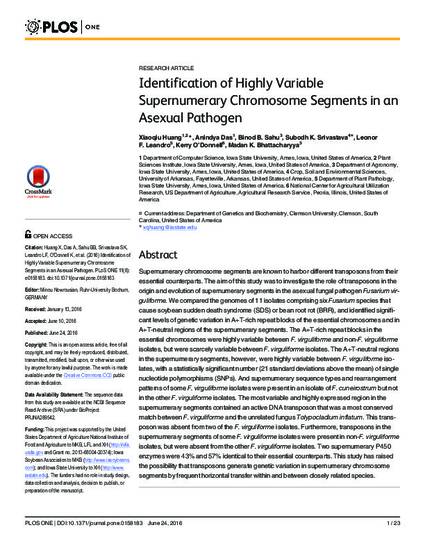
Article
Identification of Highly Variable Supernumerary Chromosome Segments in an Asexual Pathogen
PLoS One
Document Type
Article
Disciplines
Publication Version
Published Version
Publication Date
1-1-2016
DOI
10.1371/journal.pone.0158183
Abstract
Supernumerary chromosome segments are known to harbor different transposons from their essential counterparts. The aim of this study was to investigate the role of transposons in the origin and evolution of supernumerary segments in the asexual fungal pathogen Fusarium virguliforme. We compared the genomes of 11 isolates comprising six Fusarium species that cause soybean sudden death syndrome (SDS) or bean root rot (BRR), and identified significant levels of genetic variation in A+T-rich repeat blocks of the essential chromosomes and in A+T-neutral regions of the supernumerary segments. The A+T-rich repeat blocks in the essential chromosomes were highly variable between F. virguliforme and non-F. virguliforme isolates, but were scarcely variable between F. virguliforme isolates. The A+T-neutral regions in the supernumerary segments, however, were highly variable between F. virguliforme isolates, with a statistically significant number (21 standard deviations above the mean) of single nucleotide polymorphisms (SNPs). And supernumerary sequence types and rearrangement patterns of some F. virguliforme isolates were present in an isolate of F. cuneirostrum but not in the other F. virguliforme isolates. The most variable and highly expressed region in the supernumerary segments contained an active DNA transposon that was a most conserved match between F. virguliforme and the unrelated fungus Tolypocladium inflatum. This transposon was absent from two of the F. virguliforme isolates. Furthermore, transposons in the supernumerary segments of some F. virguliforme isolates were present in non-F. virguliforme isolates, but were absent from the other F. virguliforme isolates. Two supernumerary P450 enzymes were 43% and 57% identical to their essential counterparts. This study has raised the possibility that transposons generate genetic variation in supernumerary chromosome segments by frequent horizontal transfer within and between closely related species.
Rights
Works produced by employees of the U.S. Government as part of their official duties are not copyrighted within the U.S. The content of this document is not copyrighted.
Language
en
File Format
application/pdf
Citation Information
Xiaoqiu Huang, Anindya Das, Binod B. Sahu, Subodh K. Srivastava, et al.. "Identification of Highly Variable Supernumerary Chromosome Segments in an Asexual Pathogen" PLoS One Vol. 11 Iss. 6 (2016) p. e0158183 Available at: http://works.bepress.com/xiaoqiu-huang/5/

This is an article from PLoS One 11 (2016): e0158183, doi:10.1371/journal.pone.0158183